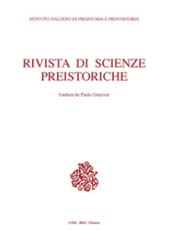Grotta dei Baffoni (Genga-AN) : i materiali degli scavi Radmilli 1952 e 1954
P. 1-36
The Baffoni Cave (Genga-AN): The materials of the 1952 and 1954 Radmilli excavations. – The critical revision of the stratigraphic succession and materials from the Baffoni Cave, supplemented with the radiocarbon dating of twelve osteological samples from different cuts, provided a more detailed chronological scanning of the Pleistocene and Holocene deposit, first published only partially. The deposit shows an almost uninterrupted anthropic frequentation from the ancient Eneolithic to protohistoric and historic periods. This is confirmed by the preserved materials from the excavations of the 1950s that are presented here, many of them unpublished.
The uncertainty of a possible initial phase of frequentation of the cave in the Final Neolithic, at the end of the 5th millennium BC, is followed by evidence from the Early Eneolithic, between 3630 and 3350 BCE, with evidence of probable use for funerary purposes and perhaps also for metallurgical activities, in relation to the symbolic function that natural cavities had in this period. There followed an almost uninterrupted period of use of the cave during all phases of the Bronze Age, from the Early Bronze Age to the Late Bronze Age, most consistently during the Middle Bronze Age 1-2, which radiocarbon dating pinpoints between 1610 and 1420 BCE.
The ceramic production refers to Grotta Nuova facies, also showing influences from the Protoapennine, Farneto-Monte Castellaccio and other groups in central Italy. Ceramic elements characteristic and exclusive of the Frasassi (or Sentino) Gorge also find further confirmation, indicating the creation of vessels peculiar to these cavities, which autonomously elaborate shapes and decorations typical of the Tyrrhenian area to create valuable vessels for votive purposes. The Middle Bronze Age 3 phases, represented by a few fragments with the typical Apennine decoration, and the Recent Bronze Age, with horned elevations and other elements from the early phase, as well as a bronze dagger, are poorly documented.
The cave was also frequented in the Final Bronze Age, as attested by some typical shapes and decorations of vessels of common use and more valuable ceramics that find comparisons in the nearby Pianello di Genga incineration necropolis. Sporadic frequentation is also in the Iron Age, of which two bronze ornaments typical of Picenum production remain. The cave was also used for a long time in Ancient Roman age, from the republican to the late imperial phase, as documented by the most recent radiocarbon dating between the 4th and 6th centuries AD. [Publisher's Text]
La Grotta dei Baffoni (Genga-AN): i materiali degli scavi Radmilli 1952 e 1954. – La revisione critica della successione stratigrafica e dei materiali della Grotta dei Baffoni, integrata con le datazioni radiocarboniche di dodici campioni osteologici provenienti da tagli diversi, ha fornito una più dettagliata scansione cronologica e culturale del deposito pleistocenico e olocenico, mai trattata prima se non in forme parziali, che mostra una frequentazione antropica pressoché ininterrotta dall'Eneolitico antico (e anche Neolitico) ad epoche protostoriche e storiche. Ne sono conferma i materiali conservati degli scavi degli anni '50 del 1900 che qui sono presentati, molti dei quali inediti.
All'incertezza di una possibile fase iniziale di frequentazione della grotta nel Neolitico finale, alla fine del V millennio a.C., seguono testimonianze dell'Eneolitico antico, sicuramente tra 3630 e 3350 a.C., con evidenze del probabile uso per scopi funerari e, forse, anche per attività metallurgiche, in relazione alla funzione simbolica che rivestivano le cavità naturali in questo periodo. Segue un periodo di utilizzo della grotta durante tutte le fasi dell'età del Bronzo, dal Bronzo antico al Bronzo finale, più consistente durante il Bronzo Medio 1-2, che le datazioni radiocarboniche puntualizzano tra 1610 e 1420 a.C. La produzione ceramica, oltre a rimandare a Grotta Nuova, mostra influssi di ambito protoappennico, Farneto-Monte Castellaccio e di altri gruppi dell'Italia centrale.
Trovano conferma anche elementi ceramici caratteristici ed esclusivi della Gola di Frasassi (o del Sentino), che ne identificano la produzione attraverso la creazione di recipienti peculiari di queste cavità che, pur prendendo a modello fogge e decorazioni tipiche dell'area tirrenica, li elaborano autonomamente per realizzare recipienti di pregio a destinazione votiva. Scarsamente documentate le fasi del Bronzo medio 3, rappresentate da alcuni frammenti con la tipica decorazione appenninica, e del Bronzo recente, con sopraelevazioni cornute e altri elementi della fase iniziale, oltre a un pugnale di bronzo.
La grotta è stata frequentata anche nel Bronzo finale, come attestano alcune fogge e decorazioni tipiche di vasi di uso comune e di ceramiche di maggior pregio che trovano confronti nella vicina necropoli a incinerazione di Pianello di Genga e, sporadicamente, anche nella successiva età del Ferro, della quale rimangono due ornamenti in bronzo tipici della produzione picena. La grotta fu lungamente utilizzata anche in epoca romana, dalla fase repubblicana a quella tardo imperiale, come documenta anche la datazione radiocarbonica più recente, tra IV e VI secolo d.C. [Testo dell'editore]
122224 characters
-
Articles du même numéro (disponibles individuellement)
-
Informations
Code DOI : 10.32097/1269
ISSN: 2282-457X
KEYWORDS
- grotte, Eneolitico, età del Bronzo, stratigrafia, ceramica
- caves, Eneolithic, Bronze Age, stratigraphy, pottery


